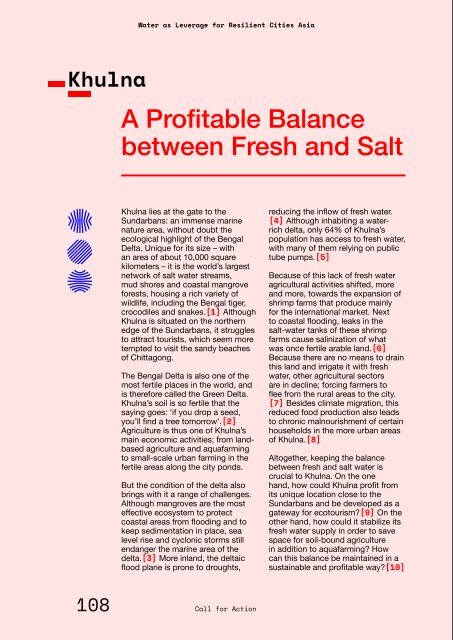Water as Leverage- Setting the scene for a call for action
- No tags were found...
Create successful ePaper yourself
Turn your PDF publications into a flip-book with our unique Google optimized e-Paper software.
<strong>Water</strong> <strong>as</strong> <strong>Leverage</strong> <strong>for</strong> Resilient Cities Asia<br />
Khulna<br />
A Profitable Balance<br />
between Fresh and Salt<br />
[5]<br />
[4]<br />
Khulna lies at <strong>the</strong> gate to <strong>the</strong><br />
Sundarbans: an immense marine<br />
nature area, without doubt <strong>the</strong><br />
ecological highlight of <strong>the</strong> Bengal<br />
Delta. Unique <strong>for</strong> its size – with<br />
an area of about 10,000 square<br />
kilometers – it is <strong>the</strong> world’s largest<br />
network of salt water streams,<br />
mud shores and co<strong>as</strong>tal mangrove<br />
<strong>for</strong>ests, housing a rich variety of<br />
wildlife, including <strong>the</strong> Bengal tiger,<br />
crocodiles and snakes.[1] Although<br />
Khulna is situated on <strong>the</strong> nor<strong>the</strong>rn<br />
edge of <strong>the</strong> Sundarbans, it struggles<br />
to attract tourists, which seem more<br />
tempted to visit <strong>the</strong> sandy beaches<br />
of Chittagong.<br />
The Bengal Delta is also one of <strong>the</strong><br />
most fertile places in <strong>the</strong> world, and<br />
is <strong>the</strong>re<strong>for</strong>e <strong>call</strong>ed <strong>the</strong> Green Delta.<br />
Khulna’s soil is so fertile that <strong>the</strong><br />
saying goes: ‘if you drop a seed,<br />
you’ll find a tree tomorrow’.[2]<br />
Agriculture is thus one of Khulna’s<br />
main economic activities; from landb<strong>as</strong>ed<br />
agriculture and aquafarming<br />
to small-scale urban farming in <strong>the</strong><br />
fertile are<strong>as</strong> along <strong>the</strong> city ponds.<br />
But <strong>the</strong> condition of <strong>the</strong> delta also<br />
brings with it a range of challenges.<br />
Although mangroves are <strong>the</strong> most<br />
effective ecosystem to protect<br />
co<strong>as</strong>tal are<strong>as</strong> from flooding and to<br />
keep sedimentation in place, sea<br />
level rise and cyclonic storms still<br />
endanger <strong>the</strong> marine area of <strong>the</strong><br />
delta.[3] More inland, <strong>the</strong> deltaic<br />
flood plane is prone to droughts,<br />
reducing <strong>the</strong> inflow of fresh water.<br />
[4] Although inhabiting a waterrich<br />
delta, only 64% of Khulna’s<br />
population h<strong>as</strong> access to fresh water,<br />
with many of <strong>the</strong>m relying on public<br />
tube pumps.[5]<br />
Because of this lack of fresh water<br />
agricultural activities shifted, more<br />
and more, towards <strong>the</strong> expansion of<br />
shrimp farms that produce mainly<br />
<strong>for</strong> <strong>the</strong> international market. Next<br />
to co<strong>as</strong>tal flooding, leaks in <strong>the</strong><br />
salt-water tanks of <strong>the</strong>se shrimp<br />
farms cause salinization of what<br />
w<strong>as</strong> once fertile arable land.[6]<br />
Because <strong>the</strong>re are no means to drain<br />
this land and irrigate it with fresh<br />
water, o<strong>the</strong>r agricultural sectors<br />
are in decline; <strong>for</strong>cing farmers to<br />
flee from <strong>the</strong> rural are<strong>as</strong> to <strong>the</strong> city.<br />
[7] Besides climate migration, this<br />
reduced food production also leads<br />
to chronic malnourishment of certain<br />
households in <strong>the</strong> more urban are<strong>as</strong><br />
of Khulna.[8]<br />
Altoge<strong>the</strong>r, keeping <strong>the</strong> balance<br />
between fresh and salt water is<br />
crucial to Khulna. On <strong>the</strong> one<br />
hand, how could Khulna profit from<br />
its unique location close to <strong>the</strong><br />
Sundarbans and be developed <strong>as</strong> a<br />
gateway <strong>for</strong> ecotourism?[9] On <strong>the</strong><br />
o<strong>the</strong>r hand, how could it stabilize its<br />
fresh water supply in order to save<br />
space <strong>for</strong> soil-bound agriculture<br />
in addition to aquafarming? How<br />
can this balance be maintained in a<br />
sustainable and profitable way?[10]<br />
[2]<br />
[3]<br />
[9]<br />
[8]<br />
[6]<br />
[7]<br />
[10]<br />
108 Call <strong>for</strong> Action<br />
PART 1 / From Global <strong>Water</strong> Issues to a Call <strong>for</strong> Action<br />
[1]<br />
109


















